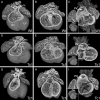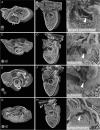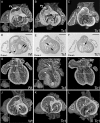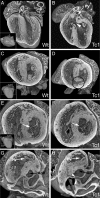Down's syndrome-like cardiac developmental defects in embryos of the transchromosomic Tc1 mouse
- PMID: 20558441
- PMCID: PMC2952533
- DOI: 10.1093/cvr/cvq193
Down's syndrome-like cardiac developmental defects in embryos of the transchromosomic Tc1 mouse
Abstract
Aims: Cardiac malformations are prevalent in trisomies of human chromosome 21 [Down's syndrome (DS)], affecting normal chamber separation in the developing heart. Efforts to understand the aetiology of these defects have been severely hampered by the absence of an accurate mouse model. Such models have proved challenging to establish because synteny with human chromosome Hsa21 is distributed across three mouse chromosomes. None of those engineered so far accurately models the full range of DS cardiac phenotypes, in particular the profound disruptions resulting from atrioventricular septal defects (AVSDs). Here, we present analysis of the cardiac malformations exhibited by embryos of the transchromosomic mouse line Tc(Hsa21)1TybEmcf (Tc1) which contains more than 90% of chromosome Hsa21 in addition to the normal diploid mouse genome.
Methods and results: Using high-resolution episcopic microscopy and three-dimensional (3D) modelling, we show that Tc1 embryos exhibit many of the cardiac defects found in DS, including balanced AVSD with single and separate valvar orifices, membranous and muscular ventricular septal defects along with outflow tract and valve leaflet abnormalities. Frequencies of cardiac malformations (ranging from 38 to 55%) are dependent on strain background. In contrast, no comparable cardiac defects were detected in embryos of the more limited mouse trisomy model, Dp(16Cbr1-ORF9)1Rhr (Ts1Rhr), indicating that trisomy of the region syntenic to the Down's syndrome critical region, including the candidate genes DSCAM and DYRK1A, is insufficient to yield DS cardiac abnormalities.
Conclusion: The Tc1 mouse line provides a suitable model for studying the underlying genetic causes of the DS AVSD cardiac phenotype.
Figures





Comment in
-
Looking down the atrioventricular canal.Cardiovasc Res. 2010 Nov 1;88(2):205-6. doi: 10.1093/cvr/cvq302. Epub 2010 Sep 20. Cardiovasc Res. 2010. PMID: 20855523 Free PMC article. No abstract available.
Similar articles
-
Engineered chromosome-based genetic mapping establishes a 3.7 Mb critical genomic region for Down syndrome-associated heart defects in mice.Hum Genet. 2014 Jun;133(6):743-53. doi: 10.1007/s00439-013-1407-z. Epub 2013 Dec 22. Hum Genet. 2014. PMID: 24362460 Free PMC article.
-
Looking down the atrioventricular canal.Cardiovasc Res. 2010 Nov 1;88(2):205-6. doi: 10.1093/cvr/cvq302. Epub 2010 Sep 20. Cardiovasc Res. 2010. PMID: 20855523 Free PMC article. No abstract available.
-
Endocardial cushion development and heart loop architecture in the trisomy 16 mouse.Dev Dyn. 1996 Jul;206(3):301-9. doi: 10.1002/(SICI)1097-0177(199607)206:3<301::AID-AJA7>3.0.CO;2-M. Dev Dyn. 1996. PMID: 8896985
-
Molecular determinants of atrial and ventricular septal defects and patent ductus arteriosus.Am J Med Genet. 2000 Winter;97(4):304-9. doi: 10.1002/1096-8628(200024)97:4<304::aid-ajmg1281>3.0.co;2-#. Am J Med Genet. 2000. PMID: 11376442 Review.
-
The pathogenesis of atrial and atrioventricular septal defects with special emphasis on the role of the dorsal mesenchymal protrusion.Differentiation. 2012 Jul;84(1):117-30. doi: 10.1016/j.diff.2012.05.006. Epub 2012 Jun 17. Differentiation. 2012. PMID: 22709652 Free PMC article. Review.
Cited by
-
3-dimensional imaging modalities for phenotyping genetically engineered mice.Vet Pathol. 2012 Jan;49(1):106-15. doi: 10.1177/0300985811429814. Epub 2011 Dec 6. Vet Pathol. 2012. PMID: 22146851 Free PMC article. Review.
-
A non-mosaic transchromosomic mouse model of down syndrome carrying the long arm of human chromosome 21.Elife. 2020 Jun 29;9:e56223. doi: 10.7554/eLife.56223. Elife. 2020. PMID: 32597754 Free PMC article.
-
Molecular mechanisms of congenital heart disease in down syndrome.Genes Dis. 2019 Jul 8;6(4):372-377. doi: 10.1016/j.gendis.2019.06.007. eCollection 2019 Dec. Genes Dis. 2019. PMID: 31832516 Free PMC article. Review.
-
Engineered chromosome-based genetic mapping establishes a 3.7 Mb critical genomic region for Down syndrome-associated heart defects in mice.Hum Genet. 2014 Jun;133(6):743-53. doi: 10.1007/s00439-013-1407-z. Epub 2013 Dec 22. Hum Genet. 2014. PMID: 24362460 Free PMC article.
-
Trisomic and allelic differences influence phenotypic variability during development of Down syndrome mice.Genetics. 2011 Dec;189(4):1487-95. doi: 10.1534/genetics.111.131391. Epub 2011 Sep 16. Genetics. 2011. PMID: 21926299 Free PMC article.
References
-
- Sherman SL, Allen EG, Bean LH, Freeman SB. Epidemiology of Down syndrome. Ment Retard Dev Disabil Res Rev. 2007;13:221–227. doi:10.1002/mrdd.20157. - DOI - PubMed
-
- Freeman SB, Taft LF, Dooley KJ, Allran K, Sherman SL, Hassold TJ, et al. Population-based study of congenital heart defects in Down syndrome. Am J Med Genet. 1998;80:213–217. doi:10.1002/(SICI)1096-8628(19981116)80:3<213::AID-AJMG6>3.0.CO;2-8. - DOI - PubMed
-
- Korenberg JR, Chen XN, Schipper R, Sun Z, Gonsky R, Gerwehr S, et al. Down syndrome phenotypes: the consequences of chromosomal imbalance. Proc Natl Acad Sci USA. 1994;91:4997–5001. doi:10.1073/pnas.91.11.4997. - DOI - PMC - PubMed
-
- Delabar JM, Theophile D, Rahmani Z, Chettouh Z, Blouin JL, Prieur M, et al. Molecular mapping of twenty-four features of Down syndrome on chromosome 21. Eur J Hum Genet. 1993;1:114–124. - PubMed
-
- Korbel JO, Tirosh-Wagner T, Urban AE, Chen XN, Kasowski M, Dai L, et al. The genetic architecture of Down syndrome phenotypes revealed by high-resolution analysis of human segmental trisomies. Proc Natl Acad Sci USA. 2009;106:12031–12036. doi:10.1073/pnas.0813248106. - DOI - PMC - PubMed
Publication types
MeSH terms
Grants and funding
LinkOut - more resources
Full Text Sources
Medical
Molecular Biology Databases

